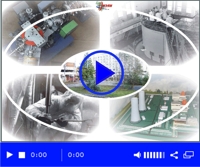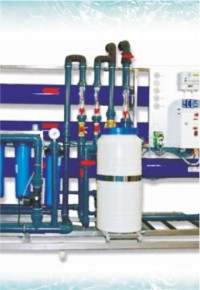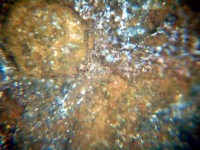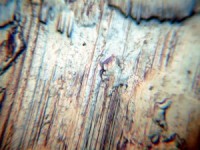Laboratory of Forms of Radionuclides (Metal Ions) in Solutions # 06
Mrs. Valentina TOROPOVA
Tel.: +375 (17) 373-13-41
Fax: +375 (17) 374-83-35
E-mail: lab06@sosny.bas-net.by
History:
The Laboratory was founded in 1969 by the Institute of Nuclear Energy of the Academy of Sciences of the BSSR under the direction of Doctor of Chemistry, professor Yu.P.Davydova.
9 candidates of sciences were trained in the laboratory. At present, the number of employees is 9, including 1 candidate of science, 5 research workers, 1 leading engineer-technologist, 1 technician.
Main research fields:
The main scientific direction of the laboratory is the study of the state of radionuclides (metal ions) in solutions of various compositions in order to create effective methods for solving industrial and environmental problems.
Fundamental research:
– hydrolysis of metal ions with formation of mononuclear and polynuclear hydroxocomplexes, determination of the influence of various factors on hydrolysis (solution pH, temperature, radionuclide concentration, concentration and nature of complexing anions, presence and concentration of extraneous cations in solution);
– determination of the composition, structure and charge of polynuclear hydroxocomplexes;
– study of sorption and catalytic properties of metal-hydroxide complexes;
– determination of the composition, structure, thermodynamic and kinetic stability of radionuclide complexes in solution in the presence of various complexing agents, including components of deactivating solutions and liquid radioactive waste from nuclear power plants;
– creation of oxide / hydroxide catalysts for the decomposition of organic compounds by chemical methods;
– study of physical and chemical characteristics of the main radionuclides and activated corrosion products in solutions in the presence of anions, that are components of deactivating solutions and liquid radioactive waste from nuclear power plants.
Applied research:
– development of a complex of innovative technologies for decontamination of equipment and facilities of nuclear power plants, including low-waste (membranous),
– development and adaptation of technologies for processing liquid radioactive waste of complex radiochemical composition, which are formed, among other things, in the operation of nuclear power plants;
– analysis of the influence of the water-chemical regime of technological mediums on the operation of the systems and equipment of the Belarusian NPP;
– development of proposals for the improvement of the technological regulations for water treatment of the Belarusian NPP, taking into account the chemical composition of the feed water, as well as the trends towards the introduction of membrane water purification;
– study of the sorption properties of the Belarusian oil shale in relation to radionuclides and heavy metals;
– development of the compositions for cleaning equipment of industrial enterprises and heat-and-power equipment from iron-oxide, carbonate, silicate, mud-oil, paint and other pollution;
– examination of documents substantiating the provision of nuclear and radiation safety of nuclear power facilities in terms of radioactive waste management, decontamination, water-сhemistry regime and water treatment.
Projects, scientific programs;:
At present the laboratory performs a number of works within the framework of:
– subprogram 6 “Scientific support for the development of nuclear energy in the Republic of Belarus” of the State program “Science intensive technologies and technics” for 2016-2020;
– subprogram 1.3 “Nuclear Power and Nuclear Physics” of the State program of scientific research “Energy Systems, Processes and Technologies”;
– grant of the National Academy of Sciences of Belarus;
– business agreement.
International cooperation
Our partners in the foreign countries:
• Department of Inorganic Chemistry, Swedish Agricultural University, Uppsala, Sweden;
• Department of Chemistry and Chemical Technology, Chalmers Technical University, Gothenburg, Sweden.
Our partners in the Russian Federation:
• JSC “Radium Institute. V.G. Khlopin “, St. Petersburg;
• Institute of Catalysis SD RAS, Laboratory of catalytic methods of solar energy conversion, Novosibirsk;
• JSC “ATOMPROEKT”, St. Petersburg;
• “Institute of Environmental and Technological Problems”, Moscow.
Projects, scientific programs;:
MAJOR ACHIEVEMENTS
1. Center for Optimization of Water Technologies
The center has all the necessary laboratory equipment, as well as a bench installation, which consists of separate units simulating all known processes currently used for water treatment and sewage purification.
Various combinations of water purification methods can be practiced on the bench installation:
• Coagulation
• Flocculation
• Mechanical filtration
• Sorption processes (activated carbon, ion exchange resins and oth.)
• Membrane processes (micro-, ultra-, nanofiltration, reverse osmosis)
• Oxidizing process (ultra-violet radiation, ozonization, electro-oxidation, etc.)
The installation allows testing the proposed technology, comparing the efficiency of different technologies and justifying operating costs both in the laboratory and directly on the facilities.
2. Facility for processing liquid radioactive waste
Within the framework of the State program of scientific research “Nuclear-Physics technologies for the National Economy of Belarus”, a technology was developed and there was established a facility for the processing of liquid radioactive waste (FP LRW) of complex composition, formed as a result of the activities of scientific research laboratories of the Scientific Institution “JIPNR-Sosny”.
FP LRW is a complex, which includes the facility itself, the LRW acceptance unit, the LRW purification and concentration unit, the cementing unit, as well as auxiliary systems that ensure the operability of the facility.
FP LRW consists of various modules that can be used in several technological modes:
• macro- and microfiltration;
• coagulation and flocculation;
• selective sorption;
• ion exchange;
• nanofiltration and reverse osmosis.
FP LRW allows to purify solutions from radionuclides and to reduce the volume of radioactive waste by 350-1000 times.
3. Effective decontamination coatings
Effective deactivating compositions have been developed in the laboratory, including methods for “dry” deactivation and prevention of the spread of contaminants using polymer coatings, fixing compounds and deactivating pastes. The compositions are designed for:
– decontamination of equipment and places of nuclear power plants, radiochemical plants and other radiation hazardous facilities;
– decontamination of buildings and structures;
– decontamination and protection of vehicles and agricultural machinery;
– decontamination of ventilation systems of industrial enterprises.
Deactivating coatings are registered in the State Committee for Standardization of the Republic of Belarus. “Technical specifications” for the manufacture of deactivating formulations for decontamination of NPP equipment and places (2 units): TS BY 190341033.005-2015 « Compositions deactivating polymeric» № 0431163 dated 09.02.2015; TS BY 190341033.004-2015 « Decontaminating solution RD-3» № 0431162 dated 09.02.2015.
Major publications
The results of the research are reflected in more than 200 scientific works: 2 monographs, a textbook, articles in scientific journals, more than 20 patents, conference reports.
• Fundamentals of Radiochemistry / Yu.P.Davydov – Minsk: The High School, 2014.
• Forms of being metal ions (radionuclides) in solution / Davydov Yu.P., Davydov D.Yu. – Minsk, Belarusian science, 2011.
• Status of radionuclides in solutions / Yu.P.Davydov – Minsk, Science and technics, 1978; 1986, Japan.
• Polymer formulation for “dry” decontamination of NPP equipment and rooms / N.I.Voronik, V.V.Toropova // Radiochemistry – 2017. – V. 59. – № 2. – p. 165–169.
• Voronik, N.I. Polymer Formulation for “Dry” Decontamination of the Equipment and Rooms of Nuclear Power Plants/ N.I. Voronik, V.V. Toropova // Radiochemistry. – March 2017, Volume 59, pp 188–192.
• Radkevich, A.V., Zarubo, A.M. [et al.]. Sorption of Strontium Ions onto Mesoporous Manganese Oxide of OMS-2 Type / A.V. Radkevich, A.M. Zarubo [et al.] // Radiochemistry. – 2017. – V. 59. – No. 3. – p. 230–236.
• Radkevich, A.V., Zarubo, A.M. [et al.]. Sorption of Strontium Ions onto Mesoporous Manganese Oxide of OMS-2 Type / A.V. Radkevich, A.M. Zarubo [et al.] // Radiochemistry. – 2017. – V. 59. – No. 3. – P. 264–271.
• Vera S. Labko. Fe-silicalites as heterogeneous Fenton-type catalysts for radiocobalt removal from EDTA chelates/ Vera S. Labko [et al.] //Applied Catalysis B: Environmental. – Volume 185, 15 May 2016, Pages 353–361.
• Influence of pre-radiation annealing and laser action on the formation of near-surface radiation centers in lithium fluoride/ A.V.Radkevich and [oth.] // Journal of Applied Spectroscopy. – 2016. – V. 83. – № 6. – P. 918–923.
• Influence of thermal destruction on the sorption properties of the mineral part of the Belarusian oil shale / V.S. Labko, A.V. Radkevich, V.V. Saskovets, V.V. Toropova, G.V. Makarevich, I.A. Salnikov // International Scientific Conference “Problems of Rational Use of Natural Resources and Sustainable Development of Polesie” Report of International Scientific Conference, Minsk, 14–17 September 2016 г. in 2 volumes. V 1. / NAS of Belarus [and oth.]; editorial board: V.G.Gusakov (editor-in-chief.) [and oth.]. Minsk: Belarusian science, 2016. – 618 p. – P. 483–487.
• «Treatment of liquid radioactive waste produced by cadmium-109 by precipitation methods» / A.М. Zarubo, А.V. Radkevich // VI International Conference “Nuclear Technologies of the XXI Century”: Collection of Reports, Minsk, 25−27 October 2016 / Scientific Institution “JIPNR-Sosny” NAS of Belarus – Minsk: Law and Economics, 2016. – P. 215–220.
• Sorption purification of solutions from strontium ions by calcium and magnesium phosphates/ A.V. Radkevich [and oth.] // Radiochemistry. – 2014. – V. 56, № 1. – P. 30 – 34.
• Cobalt speciation in Aqueous Solution and Sorbents on the Basis of Natural Dolomite for Cobalt Removal/ Artsiom V. Radkevich [et al.]// Chemistry Research and Application. Cobalt. Occurrence, Uses and Properties/ Nova Science Publisher, Inc.; ed. Yamamoto Kobayashi, Haruto Suzuki. – New York, 2013. – Ch. 6. – C. 191 – 214.
• Hierarchical zeolite FeZSM-5 as a heterogeneous Fenton-type catalyst/ V.S. Labko [et al]// Journal of Catalysis. – 2013. – V. 299, March 2013. –P. 44 – 52.
• Development of a template method for the synthesis of a heterogeneous Fenton catalyst based on a hierarchical zeolite FeZSM-5/ Labko V.S. [and oth.]// Kinetics and catalysis. – V. 54, № 5. – 2013. P. 1-7.
• Sorbent based on natural dolomite for extraction of cobalt radionuclides / V.V.Toropova [and oth.]// Radiochemistry, 2011, v. 53, N 6, p. 534–537
• Processing of liquid radioactive wastes generated during NPP operation/ Yu.P.Davydov, V.V.Toropova// Energy strategy, №8 (14), march-april 2010.
• Composition and Structure of Polynuclear Chromium(III) Hydroxo Complexes/ A. Radkevich [et al.]// Inorg. Chem. 2009, 48, 10383–10388.
• The effect of complexing anions on the formation of polynuclear hydroxocomplexes of Cr(III) in aqueous solution/ D. Davydov, A. Titov, N. Toropova// Journal of molecular liquids. – 2007. – Vol.131-132. – P.168-172.
• Influence of extraneous cations on the process of hydrolysis of metal ions with the formation of polynuclear hydroxo complexes in solution/ Yu.P.Davydov, I.G.Toropov// Journal of inorganic chemistry, 2005, V. 50, №7, p. 1199-1203.
• Development of a method for regeneration of spent electrochemical decontamination solution on the basis of data on speciation of radionuclides in solution/ Yu.P.Davydov [et al.]// Czechoslovak Journal of Physics, Vol.53 (2003), Suppl. A.
• Application of radioactive anions for determination of polynuclear complexes charge/ D.Yu. Davydov [et al.]// Czechoslovak Journal of Physics, Vol. 49 (1999), Suppl. S1, pp. 909-913.
Major patents
• Solution for decontamination of metal surfaces: Patent 18458 RB, 16.07.2012.
• Method for determining the activity of strontium-90 in water: Patent 18459 RB, 27.07.2012.
• Method for producing aqueous electrolyte. Patent RB № 11109, 24.06.2008.
• Method for producing hydrogen. Patent RB № 12146. 21.04.2009
• Method for extracting a radioiod from aqueous solutions. Patent RB № 8275, 04.04.2006.
• Method of regeneration of low active deactivating solution. Patent RB № 6406, 14.04.2004.
• Method of liquid radioactive waste neutralization. Patent RB № 2651, 25.09.1998.
• Method of soil purification from radionuclides. Patent RB № 1867, 15.05.1997.
• Composition for decontamination of equipment from components and products of nuclear fuel fission. Patent RB №2630, 24.09.1998.
• Composition for decontamination of equipment from nuclear fuel components. Patent RB №2047, 15.10.1997.











